#Rhind Mathematical Papyrus
Text
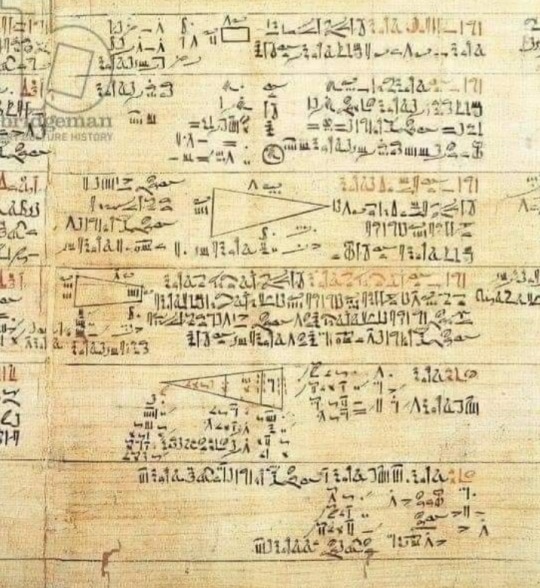
Papyrus of Ahmose or Mathematical Rhind (1500 BC / 1550 BC) is the oldest manuscript written in Algebra and Trigonometry.
Manuscript shows that Egyptians used first-order equations and solved them in several ways.
They know quadratic equations and solve them. They also know numerical and geometric sequences and know quadratic equations like two :
X2 + y2 = 100,
Y = 3/4 x, where x = 8, y = 6,
This equation is the origin of Pythagoras theorem, a2 = b 2 + c 2, and Egyptians used to call unknown number (koom).
Pythagoras developed his mathematical theories after travelling to Egypt and learning from Egyptian priests.
This has been proven in books of Greek historians and scholars such as Farpharius of Sour, Herodotus, and Thales.
Egyptians had Algebra, Trigonometry, and Geometry about 2000 years before the birth of Pythagoras and about 3000 years prior to al-Khwarizmi being born.
—
The Rhind Mathematical Papyrus (RMP; also designated as papyrus British Museum 10057 and pBM 10058) is one of the best known examples of ancient Egyptian mathematics.
It is named after Alexander Henry Rhind, a Scottish antiquarian, who purchased the papyrus in 1858 in Luxor, Egypt.
It was apparently found during illegal excavations in or near the Ramesseum. It dates to around 1550 BC.
#Papyrus of Ahmose#Mathematical Rhind#Rhind Mathematical Papyrus#manuscript#Pythagoras#Pythagoras Theorem#Ancient Egyptian Mathematics#Ancient Egypt#Alexander Henry Rhind#papyrus#Achaeo Histories#algebra#geometry#mathematics#Ahmes#Ahmose#Egyptian civilization#Trigonometry#mathematical theories#Hieroglyphs#Ramesseum
85 notes
·
View notes
Photo

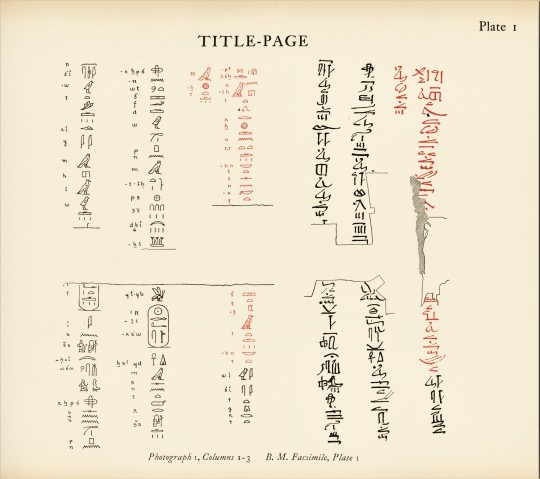
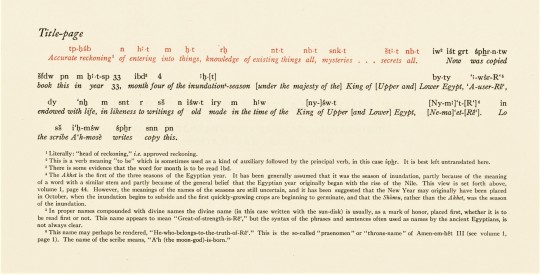



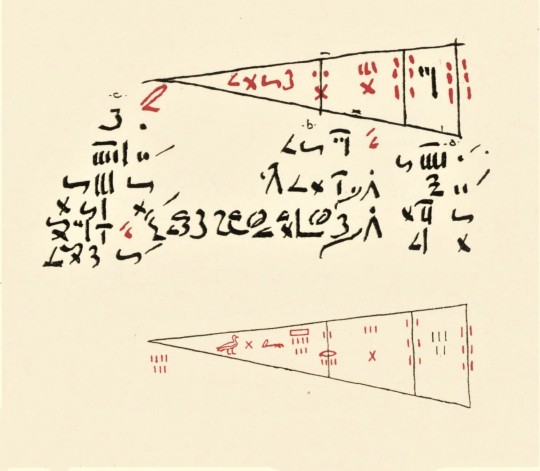



An Egyptian Mathematics Science Saturday
While Archimedes of Syracuse (287-212 BCE) is often considered the first to calculate the value of Pi (π), the Egyptians got pretty darn close a millennium and a half or so earlier, as evidenced by the Rhind Mathematical Papyrus. Copied by the scribe Ahmes sometime around 1650 BCE from an earlier text, the papyrus gives us a remarkable insight not only into Egyptian mathematics but also customs and culture, from taxation and farming practices to the exchange rate between beer and bread. It is named after Scottish antiquarian Alexander Henry Rhind, who acquired the papyrus sometime around 1858. Held by the British Museum since 1865, it is now suspected that the papyrus entered the antiquities market as a result of illegal excavations.
Our facsimile of the papyrus was the result of fifteen years of scholarship by mathematician Arnold Buffum Chace. The first volume was published in Oberlin, Ohio by the Mathematical Association of America in 1927, with the second volume following in 1929. All of the above images are from the second volume, which contains photographs of the papyrus, as well as transcription transliterations and literal translations by Chace. Chace was assisted in his work by mathematician Henry Parker Manning and Egyptologist Ludlow Seguine Bull. Also included in the second volume is a supplement to the “Bibliography of Egyptian Mathematics” from the first volume, both of which were prepared by Raymond Clare Archibald.
The first publication of the Rhind Papyrus was a translation into German in 1877 by August Eisenlohr. The Mathematical Association of America publication was part if a flurry of new scholarship surrounding the papyrus following advancements in scholarly understanding of Egyptian writing. In the preface to our edition, Chace notes the important 1923 translation by Eric Peet published by Liverpool University Press. Chace remarks that “Egyptologists ... will find philological matters fully discussed by Professor Peet,” while he intended for his work to be geared towards both mathematicians and the general public.
Both volumes were originally donated to the Library of the State Teachers College Milwaukee by the Carnegie Corporation of New York with their bookplate.
Check out more Science Saturday posts here.
-Olivia, Special Collections Graduate Intern
#Science Saturday#Rhind Papyrus#Rhind Mathematical Papyrus#Ahmes#Ahmose#Alexander Henry Rhind#Arnold Buffum Chace#Arnold Chace#Mathematical Association of America#Henry Parker Manning#Ludlow Seguine Bull#Raymond Archibald#August Eisenlohr#Eric Peet#Mathematics#Mathematics in Antiquity#Antiquities#Papyrus#olivia
34 notes
·
View notes
Text
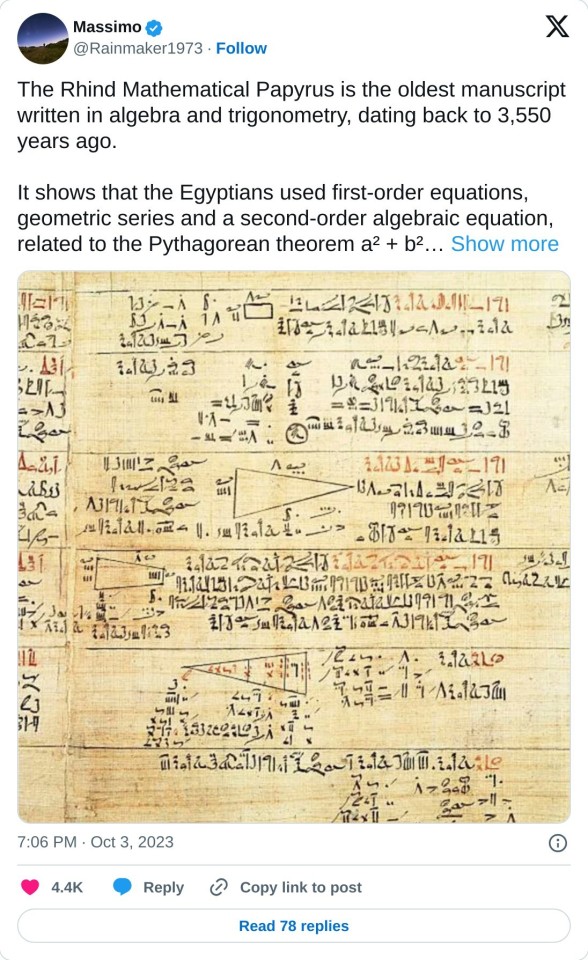
1 note
·
View note
Text

A vignette from the Rhind Mathematical Papyrus, one of the best known examples of Ancient Egyptian mathematics. Written in the hieratic script.
Second Intermediate Period, 15th Dynasty, ca. 1550 BC.
Now in the British Museum. EA 10058
259 notes
·
View notes
Text
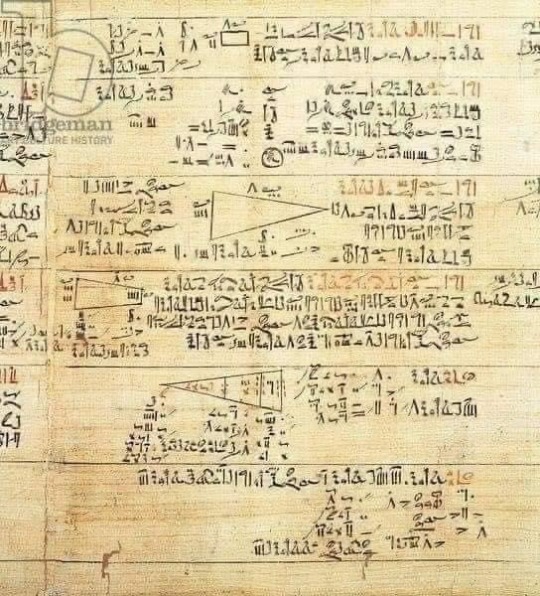
Rhind Mathematical Papyrus - the oldest (1650 BC) manuscript written in Algebra and Irigonometry.
"Rhind Mathematical Papyrus": It is named after Alexander Henry Rhind, a Scottish antiquarian. He bought the papyrus in 1858 in Luxor, Egypt. It was found during illegal excavations in or near the Ramesseum. The Rhind papyrus dates to the Second Intermediate Period of Egypt. It was copied by the scribe Ahmose from a now-lost text from the reign of Amenemhat III (12th dynasty).
The Papyrus is probably a mathematics textbook, used by scribes to learn to solve particular mathematical problems by writing down appropriate examples. The papyrus has work and writing on arithmetic, algebra, geometry, trigonometry, and fractions. Eighty-four problems are included in text covering tables of divisions, multiplication and handling of fractions; and geometry, including volumes and areas.
The scribe dated papyrus in year 33 of Apophis, the penultimate king of the Hyksos 15th Dynasty. The other side of the papyrus mentions 'year 11' without a king's name, but with a reference to the capture of the city of Heliopolis. In the opening paragraphs of the papyrus, Ahmose presents the papyrus as giving "Accurate reckoning for inquiring into things, and the knowledge of all things, mysteries... all secrets". He continues with: This book was copied in regnal year 33, month 4 of Akhet, under the majesty of the King of Upper and Lower Egypt, Awserre, given life, from an ancient copy made in the time of the King of Upper and Lower Egypt Nimaatre (?). The scribe Ahmose writes this copy.
223 notes
·
View notes
Text



The Rhind Mathematical Papyrus, a papyrus of math problems from Ancient Egypt, circa 1550 BC
from The British Museum
In seven houses there are seven cats. Each cat catches seven mice. Each mouse eats seven ears of corn, and each ear of corn, if sown, produces seven gallons of grain. How many things are mentioned in total?

124 notes
·
View notes
Text

Wonders of the Past - a Post by Silvia S.
"The Wonders of Ahmose's Papyrus 📜
Many are curious about how the ancient Egyptians managed to construct the pyramids using intricate mathematical calculations.
The Papyrus of Ahmose, also known as the Mathematical Rhind, is the oldest known manuscript featuring algebra and trigonometry. Its origins trace back 1500 years before the time of Christ, roughly 3500 years ago.
This manuscript reveals that the Egyptians were proficient in employing first-order equations and had various methods to solve them. They were also well-versed in quadratic equations, adept at solving them, and familiar with numerical and geometric sequences.
For instance, they were capable of handling equations like:
X2 + y2 = 100,
Y = 3/4 x, where x = 8, y = 6.
This equation serves as the foundation of the Pythagorean theorem, a2 = b2 + c2, and in Egyptian terms, the unknown number was referred to as "koom."
Also nwe should note that Pythagoras developed his mathematical theories after a visit to Egypt, where he learned from Egyptian priests. This historical fact has been substantiated by Greek historians and scholars like Farpharius of Sour, Herodotus, and Thales.
Remarkably, the Egyptians had mastered algebra, trigonometry, and geometry approximately 2,000 years before Pythagoras was born, and even around 3,000 years prior to the birth of al-Khwarizmi.
Today, this invaluable papyrus can be found in the British Museum in London."
97 notes
·
View notes
Note
Hey, I don't want to bother you too much, and feel free to ignore this ask, but do you know of any good explanations or resources on ancient egyptian mathematics. No probs if you don't!
Ermmm….let me get this out of the way first:
this beautiful bitch
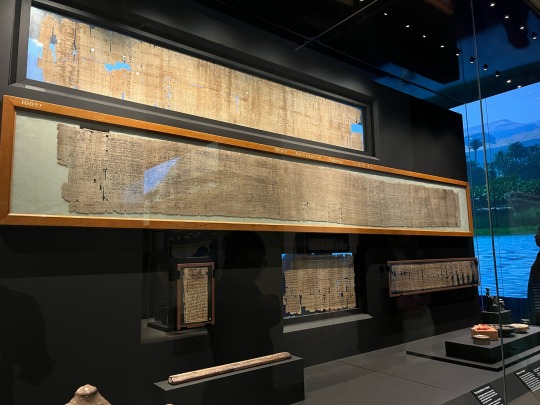
The long papyrus in the middle is the Rhind Mathematical papyrus, and it's amazing.
Anyway, books or resources on Egyptian mathematics won't be easily attainable. Truly. It's not my particular area because maths is my weakness (dyslexia but for maths squad unite!), but if you go to Wikipedia the page on the Rhind Mathematical Papyrus it is incredibly detailed with good sources. The pages on various interests such as the 2/n table and fractions are also very good (you can get to these from the RMP page) and contain a lot of sources for Egyptian mathematics too. The Fractions page in particular has A Lot of good sources which should be fairly easy to get your hands on.
255 notes
·
View notes
Text
Egy korsó régészet
A sör régészete
A sör az egyik legkedveltebb alkoholos ital a bor mellett. A hazai sörfogyasztás 60-70 liter/fő (15 év feletti) között mozgott 2019 és 2020 között, ami csupán a 26. helyre sorolja kis országunkat a világranglistát tekintve. Az első helyen, nem meglepő módon, a csehek állnak a hazai fogyasztás több mint kétszeresével.[1]

(Diagram a sörfogyasztásról 1. kép)
A sör fogyasztásának mennyisége csupán történetének hosszúsága mellett törpül el, így egy jó hideg korsónyi mellett most hadd invitáljuk meg olvasóinkat egy rövid régészeti áttekintésre e nedű történetéről.
A legkorábbi bizonyíték malátázott gabona készítéséről és annak fermentálásáról a Natúf-kultúra által használt Raqefet-barlangból, a mai Izrael területéről került elő és Kr.e. 11000 körülre datálják. A barlangot 1956-ban fedezték fel, ami kultúra temetkezési helyeként szolgált, s ennek padlójában figyelték meg az ember vájta tölcséreket. Ezekben a tölcsérekben szerves anyagokat figyeltek meg és a mintavételekből kiderült, hogy sörfőzéshez köthető kémiai nyomokat viselnek.[2]
Az első írásos emlékek a sör készítéséről és annak fajtáiról Mezopotámiából származnak, a korai iratokban 9 féle sör típust különböztetnek meg aszerint, hogy mit tartalmaznak és mekkora űrtartalomban tárolják. A későbbi időszakban ez megváltozik és a különböző típusokat a minőségük szerint írják le, mint aranysör, barnasör, édes barnasör, vörössör és szűrt sör. Az összetevők leírása vagy inkább jelölése is változik korszakonként, azonban bizonyos elemek, mint a bappir, a sörkenyér, megőrzik alakjukat és nyomon követhetőek, mely arra enged következtetni, hogy állandó és változatlan elemét képezi a technológiának.[3]
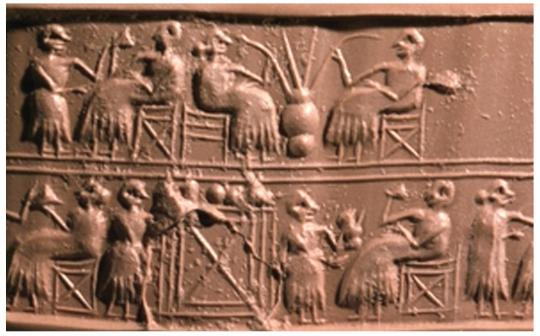
(Sumér pecséten ábrázolt sörivás 2. kép)
Az adminisztratív és irodalmi források keresztmetszetét jelenti Hammurapi törvénygyűjteménye, melyben szabályozza a kocsmaüzemeltetést (a kocsma nem szolgálhat bűnözők rejtekhelyeként vagy törvénytelen találkozók helyeként), a sörforgalmazást és a sörfogyasztás kifizetésére vonatkozó szabályokat.[4] Ebből megtudhatjuk, hogy az italért pénzzel és gabonával is lehetett fizetni, valamint a hitelbe vásárolt alkoholt a következő aratásból kellett megtéríteni.[5]
Az irodalmi szövegek közül a leghíresebb a „Himmnusz Ninkasihoz” mely három táblán maradt fenn az Óbabiloni időszakból. Ez a költemény a sörfőzés istennőjéhez szól és emelett mindhárom esetben tartalmaz még egy női kocsmáros nyitóestjéhez szóló ivóéneket. Ebben leírják a sörkészítést lépésről lépésre az alapanyagok megnevezésével, mint a bappir, a sörkenyér, melyet árpából, búzalisztből és fűszerekből készült.[6]
Az egyiptomi birodalomból is számos régészeti emléket ismerünk, melyeken a sörkészítés folyamatát ábrázolják vagy ahhoz kötődő feljegyzések szerepelnek. Ilyen a Ty sírjának domborműve, melyen a sörkészítés folyamatának minden mozzanata szerepel, valamint a Rhind Mathematical Papyrus, melyen a különböző mértékegységek átszámítási feladatai szerepelnek. Más iratokban az szerepel, hogy beérkezett gabonából a templomok és paloták számára, mennyi sör készült, melyet egy adózási irat szerint falusi munkások készítettek. Egy orvosi papíruszon tizenhét különböző sört jegyeztek le. A források alapján a sörfőzés technológiája nem változott a görög-római időkig.[7]

(Ty sírjának domborművének rajza 3. kép)
Az egyiptomi források és régészeti leletek alapján a kenyér kulcsfontosságú szerepet töltött be. Ez a fajta cipó gazdag élesztőben és enyhén sütött, hogy az élesztőgombák ne haljanak meg. A kenyeret összetörték és szűrön keresztül, vízzel passzírozták az edénybe.[8]
Egy másik gyakori összetevője az egyiptomi sörnek a datolya volt, mely növelte a fermentálódó folyadék cukortartalmát és alkohol fokát, vagy az elkészült sör ízét javította. Az íz javításának céljából vagy orvosi célokból számos fűszert és gyümölcsöt használtak, mint a dom gyümölcs, a koriander, füge, krisztustövis gyümölcs és a szikomor füge, melynek fája Nu istennő megtestesülését jelképezte és gyakori melléklete volt a síroknak.[9]
Az európai sörfőzés régészeti bizonyítékait főleg az analitikai vizsgálatok világították meg, amik alapján Machrie Moor (Isle of Arran, Scotland) i. e. 3. évezred körüli lelőhelyén tárolóedényeken találtak gabona és mézmaradványokat, ami sörből származhat. A Balfarg (Glenrothes, Fife, Scotland) lelőhelyen, melyet szintén az i. e. 3. évezredre datálnak, pollenvizsgálatokkal, a gabona mellett, réti legyezőfű és beléndek maradványait mutatták ki. Kinloch Bay-nél (Island of Rhum, Scotland) egy neolit (i. e. 2. évezred) edényben összetört gabonát, mézet és réti legyezőfüvet, hangát és királypáfrányt találtak és egyfajta sörként azonosították. North Mains (Strathallan,Perthshire, Scotland) (i. e. 1600-1500) ásatásán egy bronzkori temető feltárásánál egy fiatal nő sírjában talált edényben gabonát figyeltek meg, réti legyezőfű pollenjével valamint egy öregember sírjában ugyanezt hárs pollennel kiegészülve.[10] A dániai Egtved lelőhelyén egy bronzkori (i. e. 2. évezred) fiatal nő sírjában egy nyírfakéreg vödörben hársfa, réti legyezőfű, fehér lóhere, fenyérmirtusz, vörösáfonya, kékáfonya és árpa maradványait figyelték meg, melyet sörként azonosítottak. Hochdorf lelőhelyén pedig az említett gödrökön kívül egy edényben gabonaszemek mellett beléndek maradványait találták meg.[11]
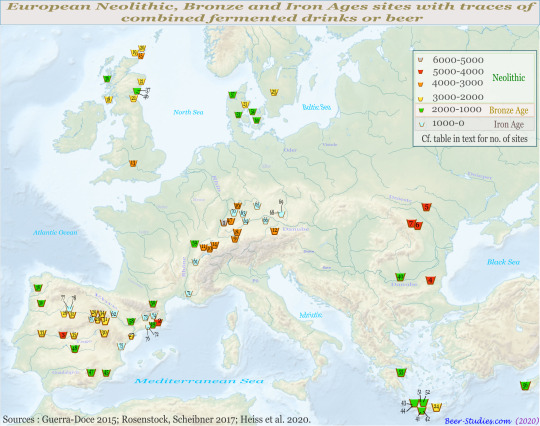
(Európai sörfőzés régészeti bizonyítékainak térképe 4. kép)
Remélem ezen gyors összegzés alatt még nem fogyott ki az a korsó és sok érdekességgel szolgáltunk eme bejegyzésünkben, mellyel gazdagítottuk olvasóink ismereteit. Egészségünkre!
Fölföldi Boldizsár
Felhasznált irodalom
Billy Quinn & Declan Moore: Fulachta fiadh and the beer experiment. In: Dining and Dwelling. 2008.
Eli Luoma: Egyptian Brewing: The Production of Beer Based on Archaeological Evidence. Wisconsin, 2009.
Elisa Guerra Doce: The Origins of Inebriation: Archaeological Evidence of the Consumption of Fermented Beverages and Drugsin Prehistoric Eurasia. In: J Archaeol Method Theory (2015) 22:751–782
Max Nelson: The barbarian’s beverage. A History of Beer in Ancient Europe. New York, 2005.
Peter Damerow: Sumerian Beer: The Origins of Brewing Technology in Ancient Mesopotamia. In: Cuneiform Digital Library Journal 2012:2.
Samuel Delwen: Brewing and baking in Ancient Egyptian materials and technology. Edited by P. T. Nicholson and I. Shaw, pp. 537-576. Cambridge: Cambridge University Press.
Sci.news Archaeology
Visual Capitalist
Beer Studies
[1] https://www.visualcapitalist.com/which-countries-drink-the-most-beer/
[2] http://www.sci-news.com/archaeology/raqefet-cave-brewery-06412.html
[3] DAMEROW 2012. 4.
[4] DAMEROW 2012. 3.
[5] KMOSKÓ 1911. 40-41.
[6] DAMEROW 2012. 3.
[7] DELWEN 2000. 539.
[8] DELWEN 2000. 537.
[9] DELWEN 2000. 558-559.
[10] GUERRA-DOCE 2015. 752-753.
[11] NELSON 2005. 12.
#hermanottómúzeum#miskolcimúzeum#miskolc#régészet#magyarrégészet#homregeszet#múzeum#sör#ital#alkohol#archaeology
72 notes
·
View notes
Text

Rhind Mathematical Papyrus, written in hieratic script. Circa 1650 B.C.
2 notes
·
View notes
Text
Egyptian Mathematics and the Greeks.
" اتفق اليونانيون أجمعين أن العلم اليوناني هو علم مأخوذ من العلوم المصرية.... ومع ذلك ، كان الكهنة المصريون متحفظين للغاية بشأن تعليم هؤلاء الطلاب الأجانب "
The GREEKS report unanimously that the Greek science was derived from Egypt.
Traveling to Egypt to seek information from the priests became a traditional episode in the life of Greek scholars and philosophers. Orpheus , Homer, Solon and Thales studied geometry from the Egyptians and among other things introduced the 3:4:5 triangle to Greece.
Thales seems to have applied the empirical rule for finding the taper of a pyramid, already known to the scribe, Ahmose, who wrote the Rhind Mathematical Papyrus in the middle kingdom, to Practical Problems.
The Egyptian priests, however were very reticent about teaching these foreign students and those of one temple referred the newcomers to their colleagues at another Temple, on the fallacious pretext that the latter were earlier.
Egyptian Mathematics and the Greeks . A. Badawy
#egyptian hieroglyphs#kemetic#kemet#egyptian#kemetism#hieroglyphics#egyptian langblr#hieroglyphics reading#ancient history#kemeticism#egyptian architecture
26 notes
·
View notes
Text
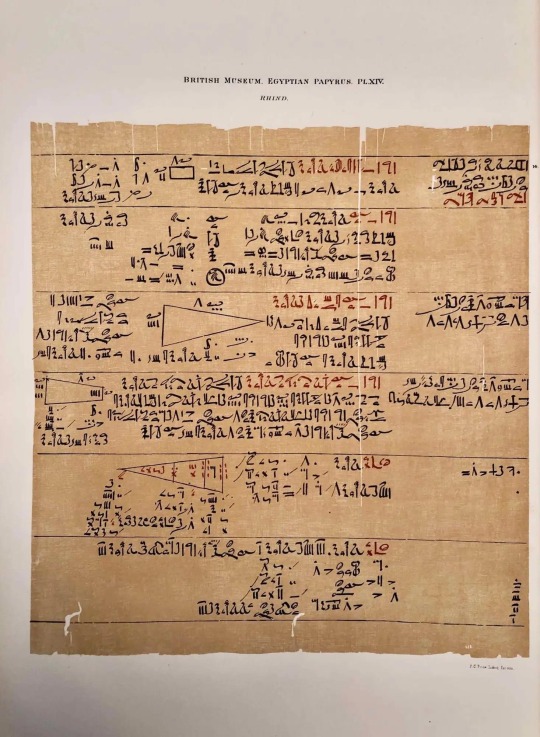
Rhind Mathematical Papyrus, 1650 BCE.
The Rhind Mathematical Papyrus is sometimes called the “Ahmes Papyrus” in honor of the scribe who compiled it. The papyrus is from the Egyptian Middle Kingdom and dates to around 1650 BCE.
It was purchased by Henry Rhind in Egypt in 1858 and placed in the British Museum in 1864 by the estate of Henry Rhind, thus it bears his name.
This papyrus was probably a mathematics textbook, used by scribes to learn to solve particular mathematical problems by writing down appropriate examples. Eighty-four problems are included in the text, including: tables of divisions, multiplication, and handling of fractions; and geometrical examinations of volumes and areas.
The manuscript shows that Egyptians used first-order equations and solved them in several ways. They also know quadratic equations and solve them. They also know numerical and geometric sequences and know quadratic equations like the two:
X2 + y2 = 100,
Y = 3/4 x, where x = 8, y = 6,
This equation is the origin of the Pythagoras theorem, a2 = b 2 + c 2, and Egyptians used to call the unknown number (koom).
Pythagoras developed his mathematical theories after travelling to Egypt and learning from Egyptian priests, and this has been proven in the books of Greek historians and scholars such as Farpharius of Sour, Herodotus and Thales.
The Egyptians had algebra, trigonometry, and geometry about 2.000 years before the birth of Pythagoras... and about 3.000 years prior to al-Khwarizmi being born. ..
https://en.wikipedia.org/wiki/Rhind_Mathematical_Papyrus
https://maa.org/press/periodicals/convergence/mathematical-treasure-the-rhind-and-moscow-mathematical-papyri
*
https://www.instagram.com/designersparty/
0 notes
Text
Cyperus papyrus

#CYPERUS PAPYRUS FULL#
Another remedy to remove a Guinea worm remains in use today, some 3,500 years later. The patient was instructed to inhale the fumes. One example of a medical remedy describes an herbal formula to be heated on a brick for asthma sufferers. It covers such medical subjects as contraception, asthma, bone-setting, dentistry and burns. It illustrates the Egyptians' knowledge of the heart as the center of the body's blood supply, but at the same time contains incantations for getting rid of demons. It has about 700 formulas and remedies of both a magical and herbal nature. The scroll is about 110 pages long and is considered one of the oldest medical documents in the world. Georg Ebers bought the document in 1873–74 at Luxor. It currently resides in the University of Leipzig library in Germany. It contains extensive herbal and medical knowledge and dates back to 1550 BC. The Ebers Papyrus is particularly famous among ancient Egyptian papyri. Papyrus D’Orbiney (Tale of Two Brothers).Papyrus Berlin 3048 ( marriage contract).Papyrus Bremner–Rhind (hymns of Isis and Nephthys).Papyrus Chester Beatty I (poetry, story of Horus and Seth).Leopold II and Amherst Papyrus (crime investigation).Judicial Papyrus of Turin (Harem conspiracy report).Papyrus Boulaq 18 (palace administration).Moscow Mathematical Papyrus (math problems).Abusir Papyri (record of Neferirkare Kakai).Egypt continued using it until the inexpensive paper became more common. Providing year-round interest, this member of the sedge family is a charming addition to the water garden thanks to its delicate evergreen appearance and fireworks-like flower. Atop the stem rests a rounded spiked umbel of yellow-green florets that turn bronze in late summer. Parchment and paper went into widespread use by the 12th century in Europe and elsewhere, however, papyrus remained an option in some places. Cyperus haspan (Dwarf Papyrus) is a rhizomatous aquatic perennial forming a tuft of upright, three-angled, green stems. Its primary rivals as a writing material included scrolls made from animal skins and the Chinese method of making paper from rags. It continued in some manner of use until about the 11th century. However, many researchers believe that papyrus was used as a writing material as early as 4,000 BC. The first instance of documented papyrus came in Egypt's first dynasty.
#CYPERUS PAPYRUS FULL#
The papyrus plant enjoys full sun and has a sensitivity to frost, like most tropical plants. These then give way to brown fruits resembling nuts. At the top of each stem sits a feathery mass of thread-like stems that give it the appearance of a feather duster.įlowers form eventually at the end of the array, forming brownish-green clusters. The plant does not have leaves, but instead grows from a clumpy, triangular mass of stems. Native to Africa, it belongs to the sedge family of Cyperaceae and grows tall, thick stands of vegetation in water. Cyperus papyrus (papyrus sedge or paper reed) is a monocot belonging to the sedge family Cyperaceae.It is a herbaceous perennial native to Africa, and forms tall stands of reed-like swamp vegetation in shallow water. Cyperus papyrus is a flowering plant that grows in water.

0 notes
Text



What is the papyrus of Ahmose, and why is it important?
Many wonder how ancient Egyptians built the pyramids with these complex geometric calculations…
The Papyrus of Ahmose or Mathematical Rhind is the oldest manuscript written in algebra and trigonometry. It dates back 1500 years before Christ, that is, about 3500 years ago.
The manuscript is important because it shows that Egyptians used first-order equations and solved them in several ways. They also know quadratic equations and solve them. They also know numerical and geometric sequences and know quadratic equations like the two:
X2 + y2 = 100,
Y = 3/4 x, where x = 8, y = 6,
This equation is the origin of the Pythagoras theorem, a2 = b 2 + c 2, and Egyptians used to call the unknown number (koom).
Pythagoras developed his mathematical theories after travelling to Egypt and learning from Egyptian priests, and this has been proven in the books of Greek historians and scholars such as Herodotus and Thales.
The Egyptians had algebra, trigonometry, and geometry about 2.000 years before the birth of Pythagoras... and about 3.000 years prior to al-Khwarizmi being born.


#kemetic dreams#egyptians#ta meri#ahmose#north east african#africans#african culture#greek#trigonometry#geometry#pythagoras#math#linear algebra#algebra#mathematical theories#herodotus#thales#greek historians#north africans#koom#al khwarizmi#born#theorem#afrakans
291 notes
·
View notes
Text
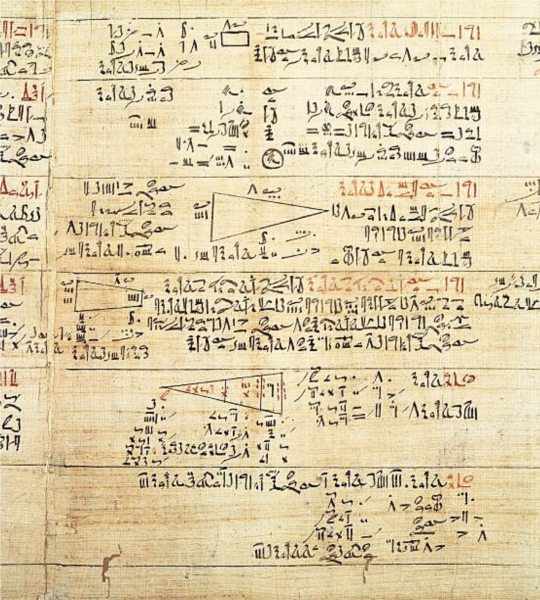
A vignette from the Rhind Mathematical Papyrus, one of the best known examples of Ancient Egyptian mathematics. Written in the hieratic script. Second Intermediate Period, 15th Dynasty, ca. 1550 BC. Now in the British Museum. EA10057
66 notes
·
View notes
Text
Just to let you all know, most of the asks currently in the inbox require some research on my part because they’re cool subjects and I’d like to make good posts out of those. This does mean that it’s going to take me a little longer to get them answered, because currently my brain just nopes the fuck out as soon as I grab the appropriate sources. Have good hopes that with a week of proper sleep, I’ll be able to answer them in a reasonable time frame, though!
The topics are (just so you can cross-reference that I received the ask just not yet answered it):
symbolism/connotations of wildlife
heka (and what I’ve done with it in my writing)
lapis lazuli
heb sed
rhind mathematical papyrus
hatshepsut’s diabetes
portrayal of daughters/children in art
sobekneferu
The other two (kingsmill, memes) are forthcoming this weekend!
27 notes
·
View notes